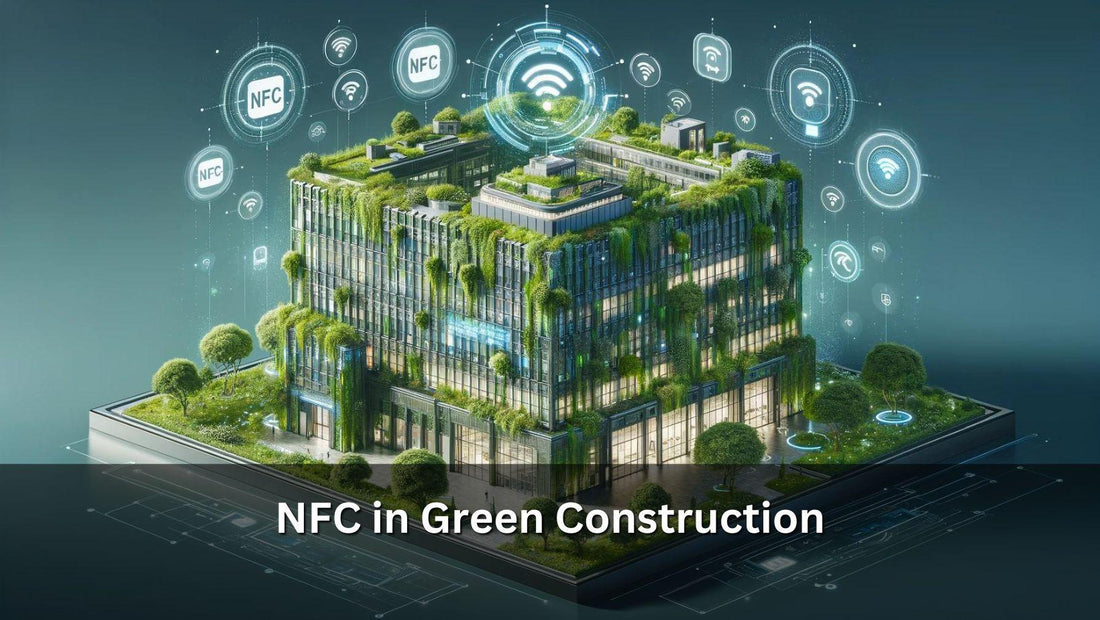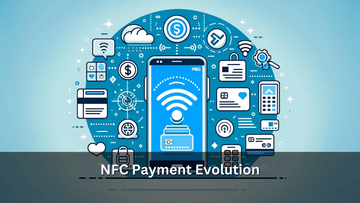NFC in Green Construction

Overview of NFC Technology
Near Field Communication (NFC) is a set of communication protocols that enable two electronic devices, one of which is usually a portable device such as a smartphone, to establish communication by bringing them within 4 cm (1.6 in) of each other. Originating from radio frequency identification (RFID) technology, NFC facilitates both one-way and two-way interactions, allowing devices not only to gather information from NFC tags but also to exchange data with other NFC-capable devices.
In the context of sustainable building practices, NFC's potential is increasingly recognized. By embedding NFC tags in construction materials or components, stakeholders can access a wealth of information—from the origin and environmental footprint of materials to maintenance records and recycling instructions—simply by scanning these tags with an NFC-enabled device. This seamless flow of information enhances material traceability, promotes efficient resource use, and supports the lifecycle management of building components, thereby contributing to the broader goals of sustainability and energy efficiency in the construction industry.
NFC's Role in Sustainability
NFC technology plays a pivotal role in advancing sustainability within the construction sector, offering innovative solutions that align with environmental conservation and efficiency objectives. Its application in sustainable building practices underscores a commitment to minimizing the environmental footprint through improved material management and resource optimization. NFC enables the digital tracking and management of materials throughout their lifecycle, from production and installation to maintenance and eventual recycling or disposal. This digital traceability ensures materials are sourced responsibly, used efficiently, and recycled properly, significantly reducing waste and promoting circular economy principles in construction.
Furthermore, NFC aids in the efficient operation of green buildings by facilitating the integration of smart systems for energy management. By allowing for the easy exchange of data between building components and management systems, NFC supports the optimization of energy use, ensuring that buildings not only consume less energy but also contribute to a lower carbon footprint. This efficiency extends beyond energy to encompass water usage and waste management, making buildings more sustainable in their operation and less impactful on the environment. Through these contributions, NFC technology emerges as a key enabler of sustainability goals in the construction industry, offering a path towards more eco-friendly and efficient building practices.
Benefits of NFC in Building Materials
The integration of Near Field Communication (NFC) technology into building materials, especially those derived from plants, marks a significant advancement in green construction. NFC-equipped materials offer enhanced performance, durability, and energy efficiency, contributing to the development of buildings that are not only more sustainable but also functionally superior.
Firstly, NFC allows for the precise tracking and authentication of sustainable materials. By embedding NFC tags in plant-based building components, manufacturers can store detailed information about the material's origin, processing, and environmental impact. This capability ensures that only the highest-quality, sustainably sourced materials are used in construction, leading to buildings that are both robust and eco-friendly.
Furthermore, NFC facilitates the optimization of material properties. Through smart data management, adjustments can be made in real-time to the composition or treatment of materials, improving their performance and extending their lifespan. This reduces the need for frequent replacements, lowering the overall environmental footprint.
Energy efficiency is another area where NFC shines. By enabling smarter building operations, such as efficient heating, cooling, and lighting systems that can be adjusted based on occupancy and usage data collected via NFC, buildings become more energy-efficient. This not only reduces carbon emissions but also translates into significant cost savings over the building's lifecycle.
In essence, NFC technology fosters a new era of building materials that align with the principles of sustainability, offering a pathway to greener, more efficient, and durable construction solutions.
Case Studies of NFC Applications
The practical application of NFC technology in green building projects showcases its potential to revolutionize the construction industry. Two notable case studies highlight the tangible benefits and outcomes of NFC integration.
First, the EcoSmart Building project, a pioneering green construction initiative, utilized NFC tags embedded in building materials to monitor energy consumption and control building systems efficiently. Residents and facility managers could access real-time data on energy use, adjust heating, ventilation, and air conditioning (HVAC) systems, and manage lighting through their smartphones. This integration led to a significant reduction in energy consumption, with the building achieving a 30% lower energy use compared to conventional structures, demonstrating NFC's role in enhancing energy efficiency and occupant comfort.
Another example is the Green Tower project, where NFC technology was employed to improve waste management and recycling processes. NFC tags attached to construction materials contained information on the material composition and recycling instructions. This enabled efficient sorting and recycling of materials during and after construction, significantly reducing waste sent to landfills. The project reported a 40% increase in material recycling rates, underscoring NFC's contribution to sustainable material management and waste reduction.
These case studies illustrate the versatility and effectiveness of NFC in promoting sustainability and efficiency in the construction sector, offering a glimpse into the future of green building practices.
NFC and Energy Efficiency
NFC technology plays a pivotal role in optimizing energy consumption within buildings through the implementation of smart automation systems and the enhancement of materials tracking. By embedding NFC tags in various building components and utilizing NFC-enabled devices, buildings can achieve a level of intelligent operation previously unattainable. For instance, NFC can facilitate the automation of lighting, heating, ventilation, and air conditioning (HVAC) systems. These systems can dynamically adjust based on real-time data, such as occupancy or environmental conditions, ensuring that energy is used only when and where needed, significantly reducing wasteful consumption.
Moreover, NFC enhances the tracking and management of building materials, ensuring that those with the best thermal properties are utilized efficiently. This leads to better insulation and, consequently, less energy required for heating and cooling. The integration of NFC also supports the maintenance of energy systems by providing easy access to service histories and operational data, facilitating timely repairs and adjustments to maintain optimal efficiency.
Through these applications, NFC contributes to substantial energy savings and a reduction in the carbon footprint of buildings, marking a significant step towards more sustainable and energy-efficient construction practices.
Innovations in NFC
Recent innovations in Near Field Communication (NFC) technology are significantly influencing the realm of green construction, offering new ways to enhance sustainability and efficiency. One notable innovation is the development of NFC-enabled smart windows. These windows can adjust their opacity based on the time of day or the season, optimizing natural light usage and reducing reliance on artificial lighting, thereby saving energy. Another groundbreaking application is in the field of smart waste management systems for construction sites. By tagging different materials with NFC chips, these systems can efficiently sort waste, ensuring that recyclable and reusable materials are properly identified and processed, thus minimizing landfill use and promoting sustainability.
Furthermore, advancements in NFC tag technology have led to the creation of more durable and environmentally friendly tags, made from biodegradable materials or using less energy to produce. These tags are ideal for embedding in green building materials, from structural components to interior finishes, providing a full lifecycle analysis and ensuring materials can be efficiently recycled or repurposed at the end of their use.
These innovations not only contribute to the sustainability of construction projects but also enhance operational efficiency, waste reduction, and energy management, underscoring the transformative potential of NFC in advancing green construction practices.
The Future of NFC in Green Building
The future of NFC in green building is poised to significantly impact sustainable construction, integrating with cutting-edge technologies to foster environments that are both energy-efficient and conducive to well-being. With the progression of NFC technology, smart buildings could dynamically adapt to internal and external conditions, optimizing energy use and improving indoor air quality through real-time adjustments based on IoT integration.
NFC's potential extends to enhancing the sustainability of building materials themselves, promoting a circular economy approach. Through detailed tagging, materials can be designed for sustainability and recyclability from the start, facilitating easier disassembly and reclamation processes. This shift could greatly diminish waste and reduce the carbon footprint associated with new constructions.
Furthermore, the adoption of AR and VR technologies alongside NFC offers exciting prospects for maintenance, education, and engagement with sustainable building features. Users could gain an immersive understanding of a building's sustainable attributes directly through their devices, bridging the gap between technology and user experience in green construction.
For further insight into the evolving landscape of green construction and the role emerging technologies will play, including NFC, the following articles offer a wealth of information:
- The Future of Green Construction Materials - Blueprint For Better
- Major Green Construction Trends That Are Emerging This Year - Green Building Insider
- Innovation in Green Building Sector for Sustainable Future - MDPI
These resources delve into current trends and future directions in sustainable construction, highlighting the integral role that NFC and other technologies could play in achieving greener building practices.
NFC – Maximizing Resource Efficiency
NFC technology significantly enhances resource efficiency in the construction industry, offering a streamlined approach from the production phase through to the lifecycle management of green building materials. At the production level, NFC tags attached to materials can store detailed information about sourcing, manufacturing processes, and environmental certifications. This level of transparency allows construction managers to select materials that not only meet the highest standards of sustainability but also reduce waste by ensuring the right materials are used at the right time.
During the construction phase, NFC helps in efficiently managing inventory and reducing overordering or misplacement of materials. Workers can quickly scan NFC tags to check the quantity and specifications of materials, facilitating precise use and minimizing surplus.
Throughout the lifecycle of a building, NFC provides valuable data for maintenance and eventual decommissioning. It enables easy access to information on the age, condition, and recyclability of materials, supporting sustainable maintenance practices and the responsible disposal or repurposing of materials at the end of their life. By ensuring materials are efficiently used and managed, NFC technology plays a crucial role in minimizing the environmental impact of buildings and promoting sustainability in the construction sector.
Conclusion: Embracing NFC for a Sustainable Future
Embracing NFC technology is pivotal for advancing sustainability within the construction industry. Its innovative applications—from enhancing material traceability and efficiency to optimizing energy consumption—demonstrate NFC's integral role in achieving global green building standards. By enabling smarter, more sustainable construction practices, NFC helps reduce the environmental footprint of buildings, fosters the efficient use of resources, and supports the creation of healthier, more energy-efficient living and working spaces. As the construction sector moves towards a more sustainable future, NFC technology stands out as a key enabler, pushing the boundaries of what is possible in green building and ensuring that sustainability remains at the forefront of industry priorities.
We at NFC Tagify provide all sort of NFC Solutions or you may contact us: Tel. 01600800080, Email: info@nfctagify.com








